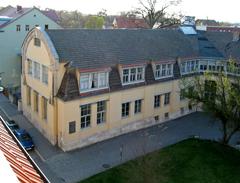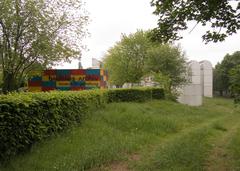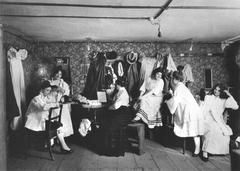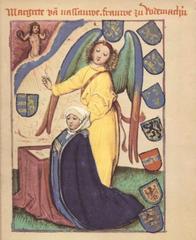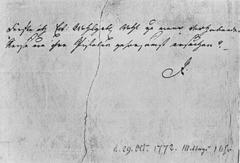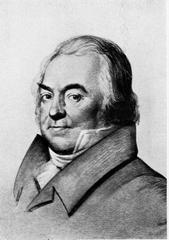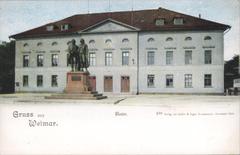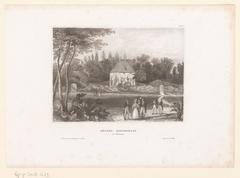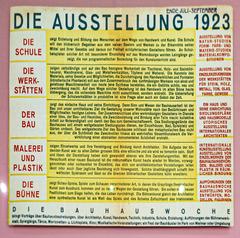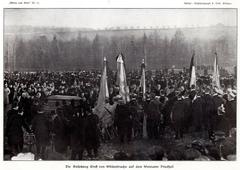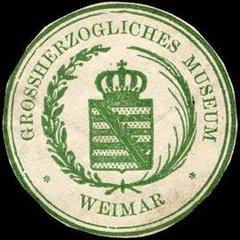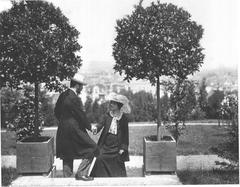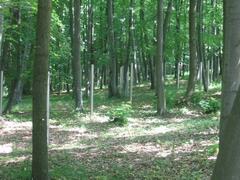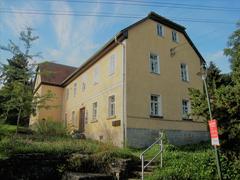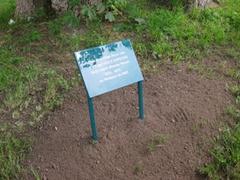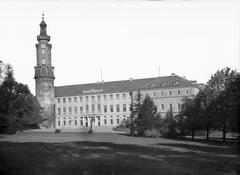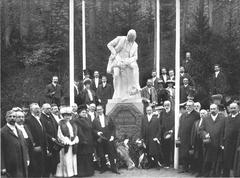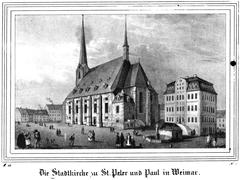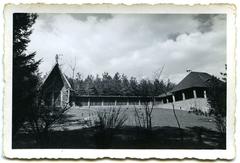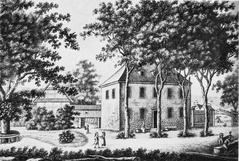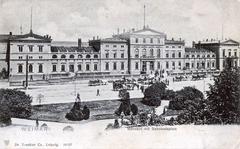
Weimarer Fürstengruft Visiting Hours, Tickets, and Travel Guide
Date: 04/07/2025
Introduction: The Significance of the Weimarer Fürstengruft
Located in the peaceful Historischer Friedhof (Historic Cemetery) of Weimar, Germany, the Weimarer Fürstengruft stands as an enduring emblem of neoclassical architecture and German cultural heritage. Commissioned in the early 19th century by Grand Duke Carl August of Saxe-Weimar-Eisenach and designed by Clemens Wenzeslaus Coudray, this mausoleum serves as the final resting place for the ducal family and the literary icons of Weimar Classicism—most notably Johann Wolfgang von Goethe and Friedrich Schiller.
The Fürstengruft is a physical manifestation of the ideals that defined the Weimar Classicism movement—symmetry, harmony, and classical beauty. It draws visitors not just for its architectural value, but for its deep entwinement with Germany’s intellectual and cultural history. The adjacent Russian Orthodox Chapel, with its gilded domes and Byzantine design, further illustrates Weimar’s cosmopolitan ties. Today, the Fürstengruft is both a UNESCO World Heritage site and a place of pilgrimage for those who wish to engage with the legacy of Weimar’s golden age.
This comprehensive guide provides everything you need to know for your visit: from historical context and architectural highlights to up-to-date visiting hours, ticketing, accessibility, and suggestions for nearby attractions. For current details, consult the Weimar city website or the Klassik Stiftung Weimar ticket shop.
Contents
- Introduction
- Historical and Architectural Overview
- Cultural and Artistic Significance
- Visiting Hours and Ticketing
- Accessibility and Visitor Tips
- Nearby Attractions
- Frequently Asked Questions (FAQ)
- Conclusion and Visitor Recommendations
- Sources and Further Reading
Historical and Architectural Overview
Origins and Setting
The Weimarer Fürstengruft (Ducal Vault) was commissioned by Grand Duke Carl August and completed in 1827, reflecting the vision of architect Clemens Wenzeslaus Coudray. Situated at the heart of the landscaped Historischer Friedhof, which was established in 1818 to embody Enlightenment ideals of dignity and remembrance, the mausoleum is both a dynastic monument and a civic landmark (Weimar City Official Website – Fürstengruft).
Architectural Features
The mausoleum’s neoclassical design features a rectangular structure capped by a prominent octagonal dome. Its façade is marked by a Doric portico with four sturdy columns, creating a sense of clarity and solemnity. The restrained use of natural stone and minimal ornamentation reflect the dignity intended by the Grand Duke. The interior is illuminated by a dome oculus, and the crypt is organized with the ducal sarcophagi arranged centrally—Goethe’s and Schiller’s memorials holding places of honor. Restoration efforts in the 1990s returned the interior to its original 19th-century color palette (Wüstenrot Stiftung – Fürstengruft Weimar).
The Russian Orthodox Chapel
Adjacent to the Fürstengruft, the Russian Orthodox Chapel was built between 1860 and 1862 for Grand Duchess Maria Pavlovna. Its golden domes and ornate iconostasis introduce Eastern Orthodox elements, reflecting the cosmopolitan connections of the Weimar court (Weimar City Official Website – Fürstengruft).
Cultural and Artistic Significance
A Pantheon for Weimar Classicism
The Fürstengruft is not only a burial site for the ducal family but also for some of Germany’s greatest cultural figures. Goethe was interred here in 1832, and Schiller’s empty sarcophagus stands beside him—his remains having never been positively identified. These associations cement the mausoleum’s reputation as a site of literary and national memory (Germany Footsteps – Things to Do in Weimar).
UNESCO Recognition
In 1998, the Fürstengruft became part of the UNESCO World Heritage ensemble “Classical Weimar,” recognized for its embodiment of Enlightenment ideals and the legacy of Weimar Classicism (Germany Footsteps – Things to Do in Weimar).
Visiting Hours and Ticketing
Opening Hours
- Winter (October–March): Monday, Wednesday–Sunday, 09:30–16:00 (closed Tuesdays)
- Summer (April–September): Monday, Wednesday–Sunday, 09:30–18:00 (closed Tuesdays)
- Public Holidays: Open, even if they fall on a regular closing day (Weimar Tourist – Fürstengruft)
Admission Fees
- Adults: €5.00
- Reduced (students, disabled, military, trainees, unemployed with proof): €4.00
- Students (16–20 years): €2.00
- Children and youth under 16: Free
- Free with the WeimarCard
Purchase tickets online via the Klassik Stiftung Weimar ticket shop—especially recommended during peak seasons.
Accessibility and Visitor Tips
Accessibility
The Fürstengruft is partially accessible: the main entrance and cemetery paths accommodate wheelchairs, but some interior spaces have steps or uneven flooring. Contact Klassik Stiftung Weimar in advance for detailed accessibility information.
Guided Tours
- Guided tours (for groups of 10+) are available by prior arrangement and provide deeper historical and architectural insights.
- Solo visitors benefit from bilingual informational panels throughout the site.
Visitor Etiquette
- Maintain a quiet and respectful demeanor; the Fürstengruft is an active burial site.
- Non-flash photography is generally allowed, but always check for posted restrictions.
- Dress modestly, especially when visiting the Russian Orthodox Chapel.
Facilities
Restrooms are available near the cemetery entrance. While there is no café onsite, Weimar’s city center—with its traditional coffee houses—is a short walk away.
Nearby Attractions
The Fürstengruft is part of a cluster of Weimar’s cultural treasures:
- Goethe National Museum: Explore the life and works of Goethe in his former residence.
- Schiller’s House: The preserved home of Friedrich Schiller.
- Bauhaus Museum: Exhibiting the groundbreaking design movement that began in Weimar.
- Ilm Park: Scenic landscape garden favored by Goethe (Duck Explore – Weimar Germany Travel Guide 2025).
Combined tickets are available for many of these sites, offering savings to those planning a broader cultural itinerary.
Frequently Asked Questions (FAQ)
What are the Weimarer Fürstengruft visiting hours?
Winter: Monday, Wednesday–Sunday, 09:30–16:00; Summer: Monday, Wednesday–Sunday, 09:30–18:00; closed Tuesdays but open on public holidays.
How do I buy tickets for the Fürstengruft?
Tickets can be purchased onsite or in advance via the Klassik Stiftung Weimar ticket shop.
Is the Fürstengruft wheelchair accessible?
Partially. Main entrances are accessible, but some interior areas may be challenging. Contact the site in advance for arrangements.
Are guided tours available?
Yes—available for groups by prior arrangement; solo visitors can use bilingual informational panels.
Can I take photographs inside?
Non-flash photography is generally allowed; always confirm on-site.
Conclusion and Visitor Recommendations
The Weimarer Fürstengruft is a profound testament to Germany’s neoclassical and literary heritage. As Goethe, Schiller, and the ducal family rest here, visitors are invited to contemplate the city’s role in shaping European intellectual life. The harmonious architecture, rich historical context, and peaceful cemetery setting make the Fürstengruft a highlight of any Weimar itinerary. Enhance your visit by exploring nearby landmarks, engaging with guided tours, and utilizing digital resources such as the Audiala app for curated cultural guides.
For the latest updates, consult the Weimar city website and follow our social media channels for news and travel inspiration.
Sources and Further Reading
- Wüstenrot Stiftung – Fürstengruft Weimar
- Angie’s Travel Routes – Weimar Sehenswürdigkeiten
- Evendo – Weimarer Fürstengruft Attraction
- Weimar City Official Website – Fürstengruft
- Germany Footsteps – Things to Do in Weimar
- Weimar Tourist – Fürstengruft
- Klassik Stiftung Weimar Ticket Shop
- Duck Explore – Weimar Germany Travel Guide 2025

